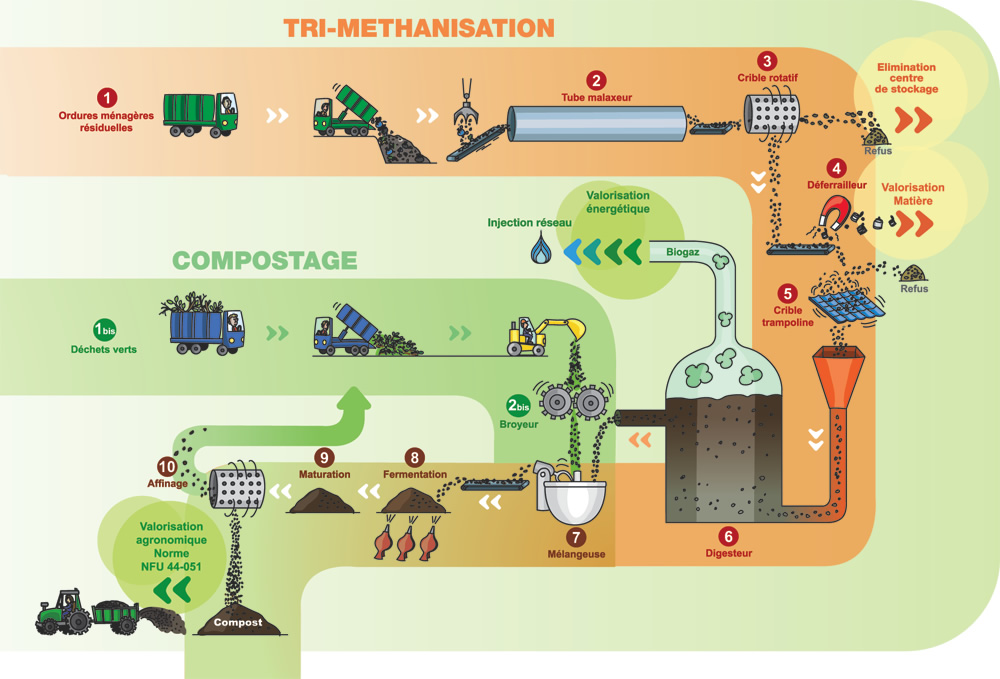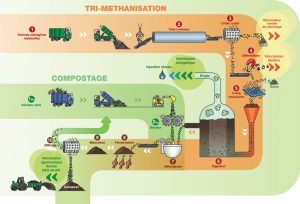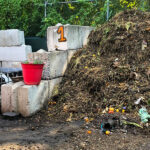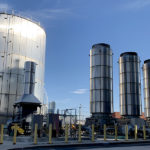The Ecocea anaerobic digestion and composting facility is expected to process 80,500 tons/year of household waste, with biomethane fed into an industrial natural gas network.
Marsha W. Johnston
BioCycle March/April 2015
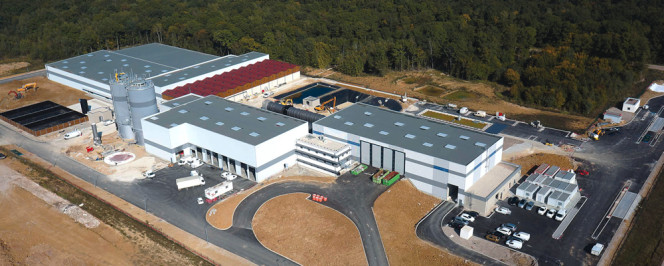
SMET 71’s anaerobic digestion and composting facility (left) is receiving mixed household waste, about half of which is comprised of organics.
Photos courtesy of SMET 71
On January 21, 2015, Ecocea, a $46 million waste treatment facility in Chagny, in eastern France, began receiving the first organic wastes for facility start-up tests. Dedicated in mid-January, the waste sorting, anaerobic digestion and composting facility is expected to process 80,500 tons/year of household waste, which has been sent to regional landfills for the last 40 years. The resulting digestate will be mixed with yard trimmings to produce 30,000 tons/year of certified compost that will be used by regional farms.
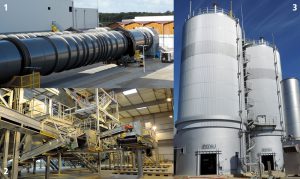
(1) Incoming waste is processed in a rotating drum sieve to separate the fermentable fraction from recyclable materials. (2) After the sieves, a rotary screen, magnets and eddy current separator are used to separate out metals, as well as nonmetal contaminants. (3) The resulting organic fraction is fed to two 51,000 cubic feet, 90-feet tall DRANCO digesters supplied by OWS.
Photos courtesy of SMET 71
SMET 71, the Saône-et-Loire regional waste management association, and Tiru, the site’s designer, builder and operator and subsidiary of the state-owned utility EDF, expect the plant to produce 2.6 million cubic meters (98.5 million standard cubic feet) of biomethane per year. By late summer, the Ecocea facility will become the first in France to inject biogas into the higher pressure, national industrial natural gas network. Via the gas pipeline, Ecocea will supply one of two local tile factories.
“This is the first injection into the high-pressure, natural gas transport network that feeds industry,” says Marie-Laure Bazerolle, spokeswoman for SMET 71, adding that the biogas production facilities operating in France primarily produce electricity and fuel for garbage trucks, while two inject biomethane into France’s low-pressure gas network (about 2 bar or 29 psig) that serves homes. The industrial gas network operates at about 65 bar or 943 psig.
“Methane capture is still new in France, but it’s growing quickly,” she continues, noting that although there has been some opposition in other areas of the country, their project went really well “because our green groups were in favor of biomethane production, which they consider better than incineration.” Furthermore, the region’s household waste elimination plan does not sanction incineration.
SMET 71’s service area includes 10 counties with a combined population of 315,000 inhabitants. Of the 80,500 tons of household waste per year, up to 40,000 tons are expected to be organics. The Ecocea facility start-up will not change the current garbage collection regime. Residents will continue to sort their waste into cardboard, paper, metals and plastics that are collected in separate bins at the source or in public receptacles in the villages, but organics will remain in the unsorted fraction, says Bazerolle. “Other localities are doing [curbside organics-only pick up], but that increases the cost a lot, and our territory is big with lots of little villages, so it’s too expensive. Sorting and elimination is handled by the municipal governments.”
Organics Processing
The process flow at Ecocea is illustrated in Figure 1. The household waste brought to Ecocea typically contains between 30 and 40 percent organic material that passes through six stages of mechanical separation before being sent to a high solids continuous digester (DRANCO), manufactured by Organic Waste Systems (OWS), a Belgium-based company. Incoming waste is processed in a comminuting drum (rotating drum sieve), which enables high performance sorting and separation of the fermentable fraction from the recyclable materials. Next, using a rotary screen, magnets, and eddy current separator, the metals are extracted from the waste. The objective is to reduce to a minimum the presence of metals in the final compost. Separated metals (aluminum, copper, iron, stainless steel, etc.) are then sold for recycling. These stages also remove other large nonmetal contaminants. Bazerolle says the predigestion separation system has been tested in two installations in France and a dozen in Europe, and she is confident that the resulting digestate will be clean enough to become farm-friendly compost.
The resulting organic fraction is fed to the two 51,000 cubic feet, 90 feet tall DRANCO digesters. Fresh waste is automatically combined with recycled digestate in a small, closed mixing unit outside the digester and then pumped to the top onto the digesting mass. This eliminates the need for mixers inside the digester. The digesters are operated continuously under thermophilic conditions (~135°F), where microbes convert the majority of the organics to biogas for an effective retention time of about 25 days. Digestate sinks by gravity and is removed from the digesters’ conical bottom, eliminating sedimentation.
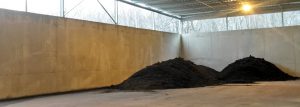
The storage area for finished compost is shown. About 30,000 tons/year of compost will be produced and marketed to farms in the region.
Photo courtesy of SMET 71
The digestate, with no dewatering, will be mixed with 8,800 tons of yard trimmings from two of the existing 10 county composting operations. The mixture will be composted and matured in aerated tunnels for 14 days.
To finance Ecocea, SMET 71 had to increase its service fees to the counties by 20 percent per year between 2012 and 2014. It contributed $38.7 million. The rest of the money came from ADEME, France’s energy agency ($1.3 million), the General Council of Saone-et-Loire ($2.2 million) and the Regional Council of Burgundy ($1.6 million).
As the first to inject biomethane into the high-pressure network, SMET 71 had to devise new guidelines for its contract with network manager GRTgaz, which is 75 percent owned by Gaz de France-Suez (GDF) and 25 percent by the French government. For its part, GRTgaz had to develop a new technique to odorize compressed biomethane, as the gas had previously been used only in the low-pressure residential network managed by sister company GRDF.
Of the three landfills in the region, one is going to close soon, but the other two will be extended until 2021. The decision to build Ecocea was based on a European Union directive that requires member states to prioritize, in order, waste source elimination, separation, composting and energy conversion, such as biogas or incineration for electricity. Bazerolle explains that while the two landfills will remain open, France’s General Tax on Polluting Activities (TGAP), which is levied by water agencies, is expected to continue to increase, bringing the overall cost of landfilling close to that of biomethane production, which benefits from a reduced TGAP. At its rated processing capacity, Ecocea will exceed the objectives in France’s national sustainable development strategy that aims to reduce landfill use by 15 percent and increase the recycling of material and organic household waste to 45 percent in 2015.
Marsha W. Johnston is Principal of Earth Steward Associates in Arlington, VA and a Contributing Writer to BioCycle.


